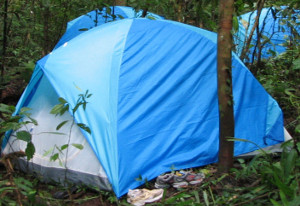
|
Setting up camp on a Peninsular (West) Malaysia forest trek is usually on natural or existing campsites. In the tropical rainforest, there are not many locations suitable for setting a campsite. Undisturbed ground is usually covered with saplings and undergrowth or the ground is sloping. It is easy to identify a campsite by its lack of undergrowth and spacing between trees. However, the presence of a campsite does not mean that the campsite is safe.
For camping beside the river, do not set up or select a campsite that is just above the water level with the river at one side and a cliff at the other side. Look for signs of eroded land feature in the form of steps beside the campsite or high watermarks on exposed rocks. This may be signs of frequent flash flood. After you have decided on a campsite, the next step is to decide on the layout and location of the tents.
Avoid camping on high, barren ground and this includes the summit. High grounds are prone to lightening strikes and thunder storms are common in tropical rainforest. Do not be tempted to camp on the summit just to watch the morning sunrise although that may be the only location with an unobstructed view.
When finding the spot to pitch tent, look up and look out for any obvious dead branches hanging overhead. Similarly, check for any dead but standing trees at the campsite. These may just come crashing down onto your tent when there is a strong wind.
Find a spot that is not too near a tree to pitch the tent. Most tropical rainforest trees have shallow roots that run above the top soil. It will be uncomfortable if you happen to sleep on top of one. If there are leaves and branches on the ground, clear them away before setting up your tent. This is to make sure there is no ants nest or animal burrows below.
Most campsites in a tropical rainforest are small. Decide on the orientation and placement of all the tents before starting to pitch the tents.
You may also wish to setup a small fire to dry your clothes and as a gathering point. There is no lack of twigs and branches but dry ones may be hard to find if it rained earlier.
Tips
Use a waterproof groundsheet to protect the base of the tent. Pitch the tent over the groundsheet and roll the excess portion under the tent's flysheet. The groundsheet will protect the base of the tent from the soil and in the event of rain, keep the base relatively dry and clean. It is easier to clean and keep a wet and dirty groundsheet than a tent with a wet and dirty base.
